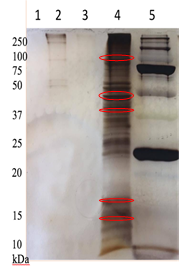Fish Stress
The proposed research will explore the presence of acute phase proteins in striped bass epidermal mucus that are released during recreational angling stress. Proteomic techniques will be used to examine changes in mucus proteins in response to different stressors such as length of handling time while hooked, length of time out of water (to remove hook), and ferocity of the fight, as well as the size (length and weight) of the fish. Base line levels of mucus proteins from captive fish will be established and used to compare against stressed fish.
Objectives
1. To characterize and quantify how the mucus protein profile changes in response to handling stress.
2. To correlate mucus protein changes with commonly used stress indicators such as cortisol levels and other protein/enzyme markers.
3. To identify possible biomarkers of stress in striped bass that can be used for future analyses.
Methods
Striped bass will be caught by recreational angling. Field assistants will time both the length of time a bass is hooked and landed, and the time out of water. Ferocity of the fight will be scored on a qualitative scale, and other measures reported such as time to hook extraction, severity of hooking, and the amount of handling (e.g. if a fish was dropped).
After landing, striped bass mucus will be sampled by swabbing with a sterile Q-tip. Samples are placed immediately into liquid nitrogen in order to arrest protease activity and maintain integrity of the samples. For analysis samples are thawed on ice, centrifuged to removed debris and lyophilized to remove excess water. If necessary samples will be dialyzed to remove excess salt. Lyophilized mucus will be resuspended in 18 mOHM distilled water and protein concentrations determined using Bradford assays. Samples will then be analysed using 1 and 2-dimensional protein electrophoresis followed by trypsin digestion and mass spectrometry. Protease determination will be done using gelatin zymography. We presently have several 1D SDS-PAGE results that confirm the efficiency of this protocol.
Results
So far we have isolated proteins from several striped bass. The work is ongoing for 2017. Check back here for results!
This figure illustrates proteins identified in striped bass epidermal mucus. Lane 5 is a marker with proteins of known molecular weights used for comparative purposes. Lane 4 is epidermal mucus collected from striped bass. The proteins circled in red identify possible biomarkers that can be used to explore out-of-water time dependent stress responses in striped bass.

Project Supervision and Funding
This project is being undertaken by Hillary Dort (B.Sc. Honours Candidate, Biology) under the supervision of Trevor Avery and Russell Easy. Hillary is following work completed by Alexandra Brown. This project is funded by the Acadia University Research Fund (Easy) and NSERC (Avery).